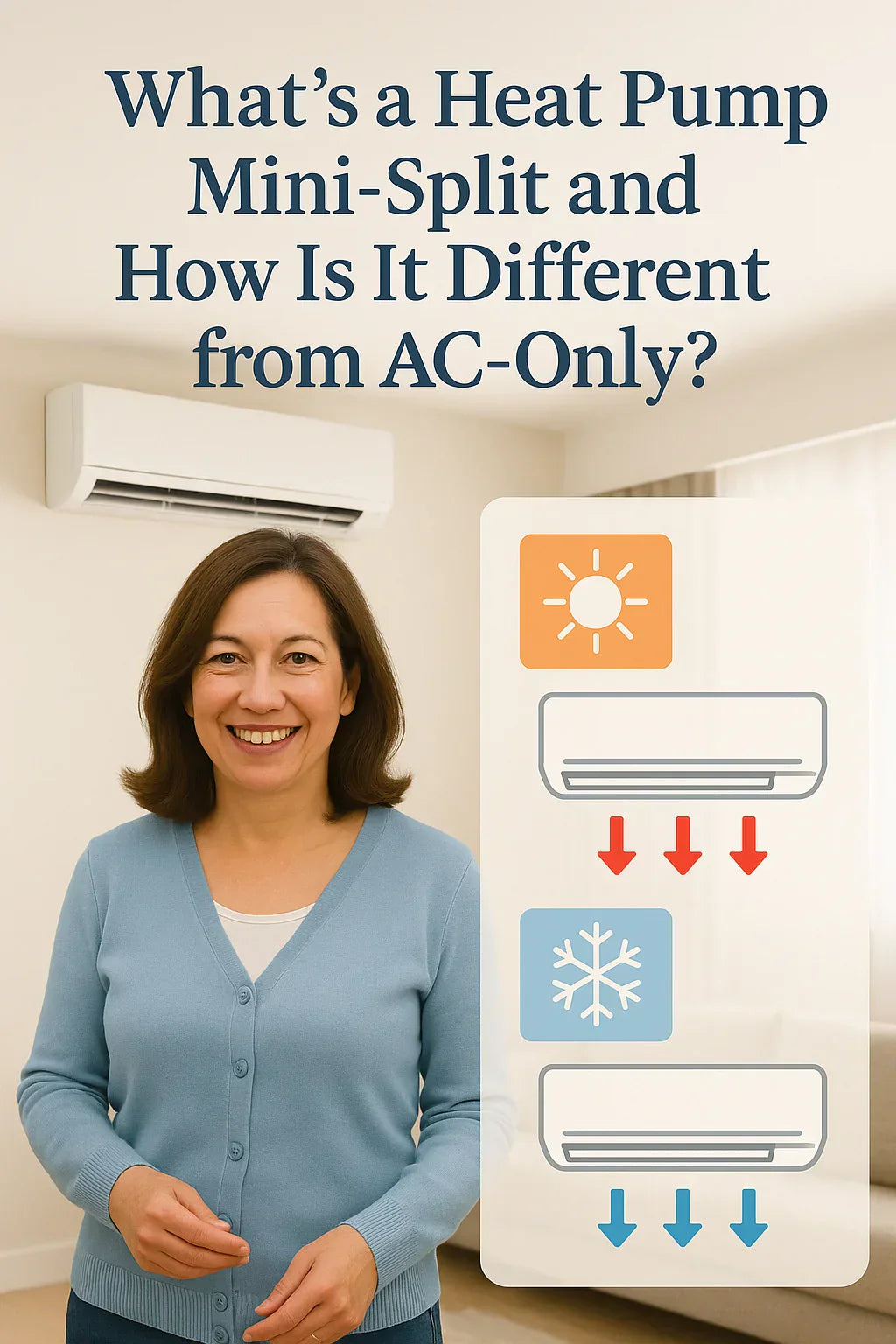🏡 Why Samantha Needs to Know
As Samantha researches ductless mini-splits, she sees options for AC-only models and heat pump mini-splits. Choosing the right system impacts: ✅ Year-round comfort ✅ Energy efficiency ✅ Upfront investment vs. long-term savings ✅ The need for additional heating systems in winter
This guide will help Samantha understand what a heat pump mini-split is, how it works, and whether it’s the best choice for her home.
⚙️ What Is a Heat Pump Mini-Split?
A heat pump mini-split is a ductless system that can both cool and heat your home by transferring heat rather than generating it.
✅ In cooling mode: It extracts heat from indoor air and moves it outside. ✅ In heating mode: It extracts heat from outside air and moves it indoors, even in cold weather. ✅ Uses refrigerant and an inverter-driven compressor to adjust output efficiently.
Learn how heat pump mini-splits work here.
❄️ What Is an AC-Only Mini-Split?
An AC-only mini-split provides cooling only and operates similarly to the cooling mode of a heat pump.
✅ Ideal for regions with mild winters where heating is unnecessary. ✅ May have a lower upfront cost. ✅ Still offers high energy efficiency and zoning benefits.
However, it cannot heat your home during winter, requiring a separate heating system if heating is needed.
🔄 Key Differences Between Heat Pump and AC-Only Mini-Splits
| Feature | Heat Pump Mini-Split | AC-Only Mini-Split |
|---|---|---|
| Cooling | ✅ | ✅ |
| Heating | ✅ | 🚫 |
| Year-Round Comfort | ✅ | 🚫 |
| Upfront Cost | Higher | Lower |
| Energy Savings | Higher | Lower |
| Cold Climate Options | ✅ | 🚫 |
✅ Heat pump mini-splits provide complete comfort in all seasons, making them a versatile option for Samantha.
🌿 Efficiency and Energy Savings
✅ Heat pump mini-splits are among the most efficient heating and cooling systems, with SEER ratings up to 33 and HSPF ratings up to 13.5. ✅ Transferring heat rather than generating it makes them 2-4 times more efficient than baseboard heaters or resistance heating. ✅ Can reduce heating bills by 20-50% depending on your previous system and climate.
Read about heat pump efficiency here.
❄️ Cold Climate Performance
✅ Modern heat pump mini-splits with hyper-heating technology (Mitsubishi, Daikin, Gree models) maintain high heating capacity even in sub-zero temperatures. ✅ Heat pumps can provide heating down to -13°F or lower, depending on the model. ✅ Samantha can often replace or significantly reduce reliance on traditional heating systems.
Explore Mitsubishi Hyper-Heating for cold climates here.
💡 When an AC-Only Mini-Split May Be Enough
✅ Samantha lives in a warm climate with mild winters. ✅ Home already has an efficient heating system. ✅ Needs to cool specific rooms (like a home office or sunroom) without additional heating needs. ✅ Prioritizing lower upfront costs over all-season versatility.
🔥 When a Heat Pump Mini-Split Is Worth the Investment
✅ Samantha wants heating and cooling in one system. ✅ Seeks to lower heating costs while adding cooling. ✅ Lives in an area with cold winters and needs reliable heating. ✅ Plans to replace an old furnace or electric baseboards. ✅ Wants a future-proof, energy-efficient solution with potential rebates.
🛡️ Rebates and Incentives
Heat pump mini-splits often qualify for: ✅ Federal tax credits under the Inflation Reduction Act (up to 30% of cost). ✅ State and local utility rebates. ✅ Manufacturer promotions.
AC-only mini-splits generally do not qualify for heating-related rebates.
Check available incentives using DSIRE.
📈 Cost Comparison: Heat Pump vs. AC-Only
| System | Typical Installed Cost |
| AC-Only Mini-Split | $3,000 - $6,500 |
| Heat Pump Mini-Split | $4,000 - $8,500 |
✅ While heat pump mini-splits cost more upfront, rebates, energy savings, and year-round comfort often offset the difference.
🧩 Real-World Scenarios for Samantha
✅ Case 1: Mild Climate (e.g., Southern California)
-
AC-only mini-split may be sufficient.
-
Use existing furnace or minimal heating needs.
✅ Case 2: Moderate Climate (e.g., Mid-Atlantic)
-
Heat pump mini-split can replace or reduce furnace usage.
-
Energy savings and comfort in winter and summer.
✅ Case 3: Cold Climate (e.g., Northeast, Midwest)
-
Heat pump mini-split with hyper-heating is ideal.
-
Can serve as the primary heat source in many homes.
🛠️ Maintenance Similarities
Both heat pump and AC-only mini-splits require: ✅ Monthly filter cleaning. ✅ Annual coil and system checks. ✅ Keeping outdoor units clear of debris.
Heat pump mini-splits may require additional winter checks for ice buildup and drainage.
Read mini-split maintenance tips here.
✅ Conclusion: Which Should Samantha Choose?
✅ Choose a Heat Pump Mini-Split if:
-
Samantha wants year-round heating and cooling.
-
Lives in an area with cold winters.
-
Wants to replace inefficient heating systems.
-
Seeks rebates and lower long-term costs.
✅ Choose an AC-Only Mini-Split if:
-
Samantha lives in a warm climate.
-
Already has a reliable, efficient heating system.
-
Wants to save on upfront installation costs.
📲 Ready to Choose Your System?
Explore Heat Pump and AC-Only Mini-Splits at The Furnace Outlet to find the right system for your climate, comfort, and energy savings goals.
In the next topic we will read more about: Is a Ductless Mini-Split System Right for Your Home?







